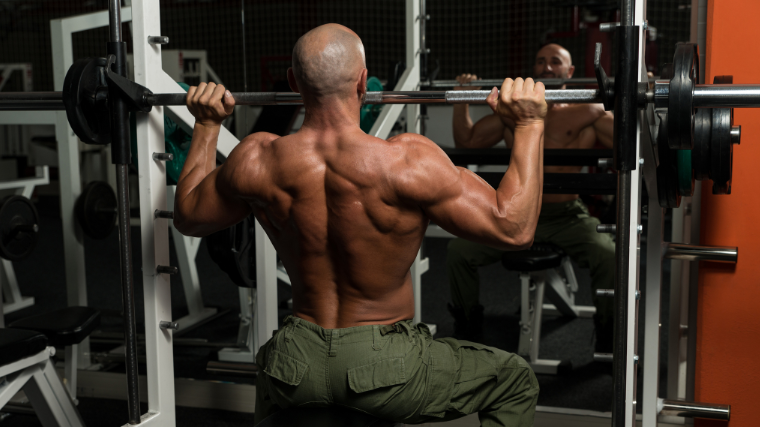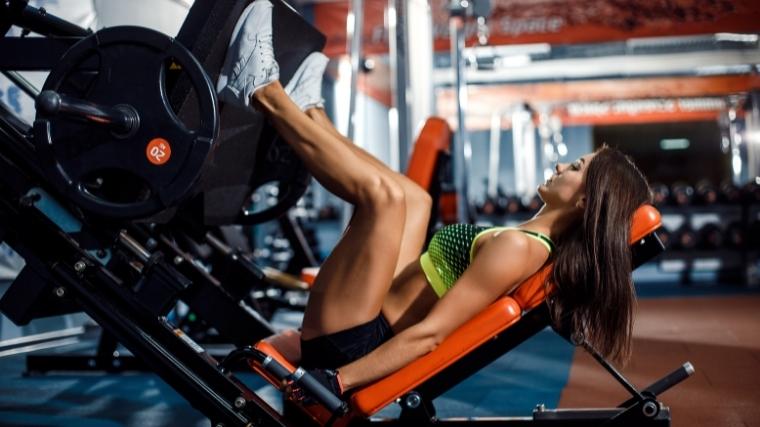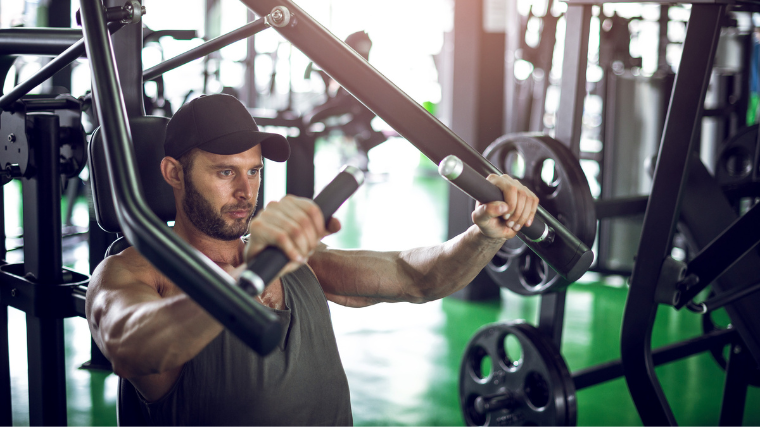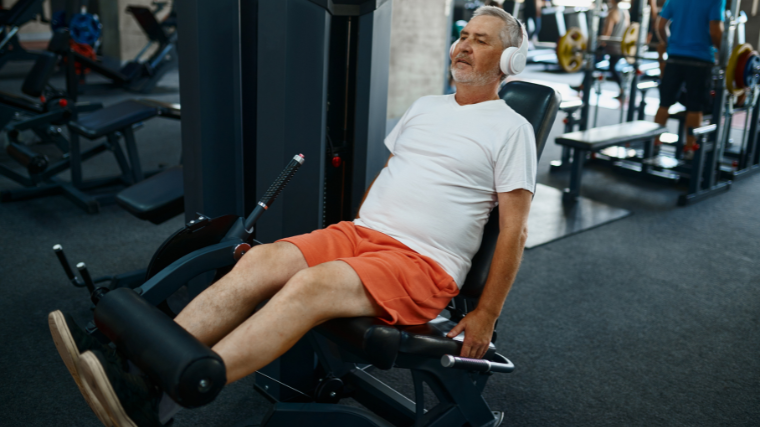Workout machines are great. They’re comfortable, beginner-friendly, and you can generally find one in most gyms for just about any exercise under the sun. Does that mean that they’re without weakness or that every workout machine in your gym is worth your time?
No way. Plain and simple, some exercise machines are more useful as a place to rest your smartphone than a tool to grow muscle or get stronger with. Other machines make lifting too easy, reinforce bad habits, or are just flat-out badly designed.

If your workouts consist of a lot of machine-based exercises, it may be time to reject modernity and embrace tradition. These are seven exercise machines you might want to consider cutting out, plus how to replace them with something better.
Worst Gym Machines
- Leg Press
- Dip Machine
- Ab Rotation Machine
- Preacher Curl Machine
- Smith Machine
- Chest Press Machine
- Sit-Up Machine
Editor’s Note: The content on BarBend is meant to be informative in nature, but it should not be taken as medical advice. When starting a new training regimen and/or diet, it is always a good idea to consult with a trusted medical professional. We are not a medical resource.
First, a Disclaimer
Labeling an exercise or piece of equipment “bad” doesn’t mean it is necessarily useless. Moreover, there are very, very few modalities in the realm of fitness that aren’t applicable to someone, somewhere, for some reason.
If you find a piece of exercise machinery to be comfortable, enjoyable, and effective, you have every right to keep using it, even if it may not be strictly “optimal” on paper.
Not every piece of gym equipment is well-designed, though, and you should keep your mind open to making some targeted changes as well.
Leg Press
Favored by plate hoarders and professional bodybuilders alike, the leg press is second to none when it comes to loading up your knee extensors with the most weight possible.
However, loading potential is only one dimension of the viability of a piece of gym equipment.

And, unfortunately, the leg press doesn’t have all that much going for it outside of enabling you to lift really, really heavy.
Why It’s Bad
While loadability is fantastic for creating progressive overload, the leg press is a bit lacking in ways that other movements excel:
- You may find it difficult to get a good range of motion going on the leg press if you’re on the larger side, as your thighs will collide with your torso.
- The angle of the footplate can make it difficult to sink into deep flexion if you have limited ankle mobility.
- If you go ultra-heavy, you may encounter some uncomfortable compressive force on your pelvis and lower back.
Instead, Try…
You can find a leg press in basically every commercial gym out there, but there’s also usually a hack squat machine right next to it.
You probably can’t lift quite as heavy on the hack squat as in the leg press, but the design of the machine lets you squat much deeper, which can offset the reduced load.
The hack squat also provides plenty of support to the torso and pelvis via the back seat, making it friendly to beginners.
If you don’t have access to a hack squat or don’t enjoy using the machine, you can also experiment with:
- Box Squat
- Trap Bar Deadlift
- Leg Extension
Dip Machine
Dips, even with your own bodyweight, can be deceptively challenging. That there’s a machine specifically designed to replicate the movement pattern is a huge boon to those who are still working on their calisthenics game.
The dip machine, though, is really less of a standard dip and more of a close-grip pressdown motion. It works your chest and triceps to a degree but lacks many of the qualities that the dip itself offers.
Why It’s Bad
To dip freely (or use a machine station), you have to have enough shoulder mobility to tolerate loaded hyperextension — your upper arm drifting behind your torso.
While this posture isn’t intrinsically dangerous, it can be challenging if you’re inflexible, working through an injury, or have a low tolerance to the range for another reason.
- The fixed handles force you to press down in a way that may not align with your structure.
- If you load up heavy enough, you might find it difficult to keep your behind planted on the seat.
- Your upper arm drifting behind your torso may be an uncomfortable or painful posture in some cases.
Instead, Try…
If you enjoy the movement pattern but don’t have it in you to perform standard dips, you can opt for the incline hex press instead, as long as you have access to a pair of dumbbells.
[Read More: Best Upper Chest Exercises for Building Muscle]
The hex press works the same muscles through a very similar range of motion as the dip machine, but allows you to move your arms according to your individual structure.
Alternatively, you can blast your chest and tris with the following movements as well:
Ab Rotation Machine
Effectively targeting your obliques can be an arduous experience, since most oblique movements (think of the side plank, for instance) require you to stabilize your entire body from head to toe.
The ab rotation station, or torso twister, is a clever solution to that problem. However, the contraption is far from practical or functional, and may in some cases be dangerous.
Why It’s Bad
To be clear, the oblique-focused ab machine, where you sit in a seat and turn your lower body from side to side, won’t necessarily cause you injury. Your spine isn’t the joint that twists; your pelvis does.
- The setup of the machine isn’t transferable to many real-world scenarios.
- Twisting your pelvis under load isn’t a movement pattern most gymgoers are accustomed to, and may lack the control to execute it properly.
- There’s a degree of torsion (twisting force) placed on the spine during the exercise, which may be a red flag for certain populations.
Instead, Try…
There are plenty of ways to train your torso that don’t involve cramming yourself into a complicated piece of machinery.
The windshield wiper is a fantastic early replacement. It requires only your bodyweight, so you can perform it anywhere, while also mirroring the movement pattern of the machine.
In lieu of that, you can also train your obliques by utilizing these moves as well:
- Dumbbell Side Bend
- Side Plank
- Side-to-Side Medicine Ball Slam
- Russian Twist
Preacher Curl Machine
The preacher curl is flat-out one of the best biceps exercises out there, and the machine variant isn’t half-bad either. That doesn’t mean it’s the best way to blow up your arms, though.
Why It’s Bad
The preacher station is far from the worst machine you can find in most gyms. Most of its weak points involve the construction of the station itself.
- Biceps activation drops off dramatically in the top half of the movement. (1)
- Most preacher curl machines have stationary handles, which removes the ability to supinate your palm as you curl — one of the biceps’ main anatomical functions.
- You might find the arm pad to be at too slight of an angle to really engage your biceps to their fullest.
Instead, Try…
If the preacher station is comfortable on your shoulders and the handles allow you to fully point your palms at the ceiling, it’s a perfectly fine biceps movement. Barring that, you might find more success from the dumbbell spider curl.
It’s the same posture as you’d take for the preacher station, but dumbbells afford you more freedom of movement at the shoulder, elbow, and wrist. Or, you can try out:
- Single-Arm Dumbbell Preacher Curl
- Standing Cable Curl
- EZ-Bar Preacher Curl
Smith Machine
In the right contexts, the Smith machine is an extremely high-value piece of equipment. Versatility aside, there’s no ignoring the fact that its design leaves something to be desired as well.
Why It’s Bad
Far and away the largest issue with the Smith relates to its on-rails, literally, design. This rigidity not only limits the scope of its usefulness, but also makes the Smith a poor tool to learn to lift with.
- The locked-in path of the bar prevents you from moving freely with the weight in a way that aligns with your anatomy.
- The bar only moves up and down, which limits your access to exercises performed in other planes of motion.
- You can’t really perform standing overhead pressing of any kind due to the height of the frame.
Instead, Try…
While the Smith machine certainly has its uses — it’s first-timer-friendly and is pretty convenient to set up and work with — you’d be better served working with a trusty barbell for most exercises.
In particular, you might want to consider going straight for the barbell for movements like:
Chest Press Machine
For a movement as simple as the chest press, you might think that the machine variant is perfectly okay — and it is, it’s fine, especially if chest development and strength is a low priority for you.

But the machine does leave a lot to be desired, and there are better ways to exercise your pecs.
Why It’s Bad
Your shoulder anatomy and bone structure strongly affects how you press. No two gymgoers will take the exact same path, but the chest press machine puts your pecs on rails.
- Most chest press machines have a narrow upper back pad, which makes it difficult to stabilize your scapula.
- The handles of the machine may not be set at an angle that is comfortable for your wrists or elbows.
- Many press machines simply move forward and backward, which omits humeral adduction entirely — drawing your arm across your body, one of the main functions of the pecs.
Instead, Try…
If you can find a pin or plate-loaded chest press machine that aligns well with your body, power to you. Barring that, you should probably ditch the thing altogether if growing or strengthening your chest is a priority in the gym.
The dumbbell floor press is a happy middle ground — you’ll get a better contraction for the pecs since you can press both up and in, while lifting from the floor provides ample stability to your back.
If that doesn’t tickle your fancy, you can also go for:
- Standing Cable Chest Press
- Bench Press
- Weighted Push-Up
Sit-Up Machine
Aspiring to abs might have you stuck on the sit-up machine, thinking it’s the best way to reveal a tight and toned midsection. The sit-up machine may work your core to a degree, sure, but it’s far from the best way to train those muscles.
Why It’s Bad
Most sit-up or crunch machines have a foldable bench that is meant to move with you as you flex your spine, as well as a pair of handles for you to grab onto.
Neither are conducive to getting the best core workout possible.
- The design of the back pad may not align well with how you actually curl your spine when you perform a crunch or sit-up.
- You may be encouraged to pull on the handles with your arms instead of focusing on contracting your abdominals.
- The handles make it very easy to load up on too much weight and turn the movement into an isometric arm exercise instead.
Instead, Try…
There are many, many different viable exercises you can use to develop your abs. To replace the machine sit-up, you might want to give a shout to the weighted exercise ball crunch instead.
The setup and execution of this movement are both quite similar to the machine sit-up, but the medicine ball provides a softer surface for you to curl your spine against.
Moreover, holding the resistance aloft in front of your body makes it impossible to pull yourself up with your arms.
On the other hand, these movements do a fine job as well:
- Cable Crunch
- Jackknife
- Hanging Leg Raise
- Ab Rollout
Machines vs. Free Weights — What the Science Says
Make no mistake, exercise machines have their place in the gym (in fact, they tend to cover a majority of the gym floor in most facilities, so they must be doing something right).
That doesn’t mean your exercise routine need necessarily start and end with them. Understanding the “when” and “why” of machine work may help you optimize your workouts and get better results long-term.
Machines Are More Beginner-Friendly
Workout machines are fantastic if you’re new to resistance training. Not only do most, if not all, exercise machines come with instructions, but they also remove the need to stabilize the weight so you can focus on squeezing your muscles instead.
You can think of machine work as“training wheels” in the weight room. They don’t pedal for you, but they help you avoid toppling over as you learn.
In fact, some literature has observed that beginners will often make comparable strength and muscle gains from working with machines instead of free weights. (2)
Machines Are Less Functional Than Free Weights
In the real world, you don’t often have the luxury of lifting something on rails. From grocery bags to boxes of Christmas decorations to a wheelbarrow packed to the brim with dirt, real-life lifting isn’t one-dimensional.
A position paper by the American College of Sports Medicine argues that exercise machines are inferior to free weights in this respect — they’re less “functional” and won’t improve your bodily coordination the way a barbell, dumbbell, or kettlebell would. (3)
Free Weights Raise Testosterone More
You may not train for better hormone levels, but there is some evidence suggesting that opting to work with free weights can improve your free testosterone concentration to a greater degree than machines. (4)
Note that this evidence is far from universally-applicable and that the degree of difference may not be significant enough to warrant making a decision over. However, it appears to be another point in favor of the barbell.
Machines Activate Less Muscle
When using a free weight like a dumbbell, you have to both move the implement in space through the proper range of motion and stabilize any unwanted or errant movement in the process.
This isn’t the case with exercise machines, which are quite literally on rails and only move in one direction.

Removing the need to stabilize the thing you’re lifting will generally result in less overall muscle activation, (5) particularly for secondary or supportive muscles.
Free Weights Reinforce Better Technique
Good form in the gym can accelerate the rate at which you make progress and make your movement more fluid and fulfilling.
To that end, free weights win out over machines. Some literature has discovered that free weights teach motor patterning better than machines — they may be harder to learn initially, but you’ll develop better and more refined lifting technique over time. (6)
Machines Are More Convenient
One of the worst parts of exercise machines is that they can only be used by one gym patron at a time — but the same is true of a pair of dumbbells. Machines earn a lot of points for their ease of access overall, though.
Setting up for an exercise like the dumbbell bench press can, at times, be more trouble than it’s worth, if you’re trying to lift in a very crowded gym or are tight on time.
Exercise machines come in clutch in this regard. As long as the station is open, training with them is as easy as sitting down, adjusting the pin (or loading the stems with plates), and getting to work.
Your Takeaways
Commercial gyms are riddled with an array of machinery designed to help you lose fat, gain muscle, or get stronger. Some exercise machines just don’t cut it for those goals, and might not be worth including in your program.
- Exercise machines place your movement “on rails,” forcing you to lift in a way that may not align with your body.
- Some machines aren’t well-made for the exercise, whether by providing insufficient support, improperly designed handles, or other features.
- Machine work requires less stability and is more convenient than using free weights, but you lose out on some muscle activation and real-world carryover as well.
Terminate the Machines
Exercise equipment shouldn’t be a “this or that” situation, at least not all the time. A wise and productive gymgoer — which you certainly are — should understand that workout machines, like dumbbells or barbells, are tools. Tools that, in the right context, can be quite useful.
However, quality does matter, and not all exercise machines are worth their salt. Some are awkward, clumsy, or inefficient, and there’s nothing to be gained by leaving them in your workouts if they don’t serve your needs.
References
- Oliveira, L. F., Matta, T. T., Alves, D. S., Garcia, M. A., & Vieira, T. M. (2009). Effect of the shoulder position on the biceps brachii emg in different dumbbell curls. Journal of sports science & medicine, 8(1), 24–29.
- Aerenhouts, D., & D’Hondt, E. (2020). Using Machines or Free Weights for Resistance Training in Novice Males? A Randomized Parallel Trial. International journal of environmental research and public health, 17(21), 7848.
- American College of Sports Medicine (2009). American College of Sports Medicine position stand. Progression models in resistance training for healthy adults. Medicine and science in sports and exercise, 41(3), 687–708.
- Schwanbeck, S. R., Cornish, S. M., Barss, T., & Chilibeck, P. D. (2020). Effects of Training With Free Weights Versus Machines on Muscle Mass, Strength, Free Testosterone, and Free Cortisol Levels. Journal of strength and conditioning research, 34(7), 1851–1859.
- Schick, E. E., Coburn, J. W., Brown, L. E., Judelson, D. A., Khamoui, A. V., Tran, T. T., & Uribe, B. P. (2010). A comparison of muscle activation between a Smith machine and free weight bench press. Journal of strength and conditioning research, 24(3), 779–784.
- McCaw, Steven T.; Friday, Jeffrey J.. A Comparison of Muscle Activity Between a Free Weight and Machine Bench Press. Journal of Strength and Conditioning Research: November 1994 – Volume 8 – Issue 4 – p 259-264
Featured Image: Undrey / Shutterstock